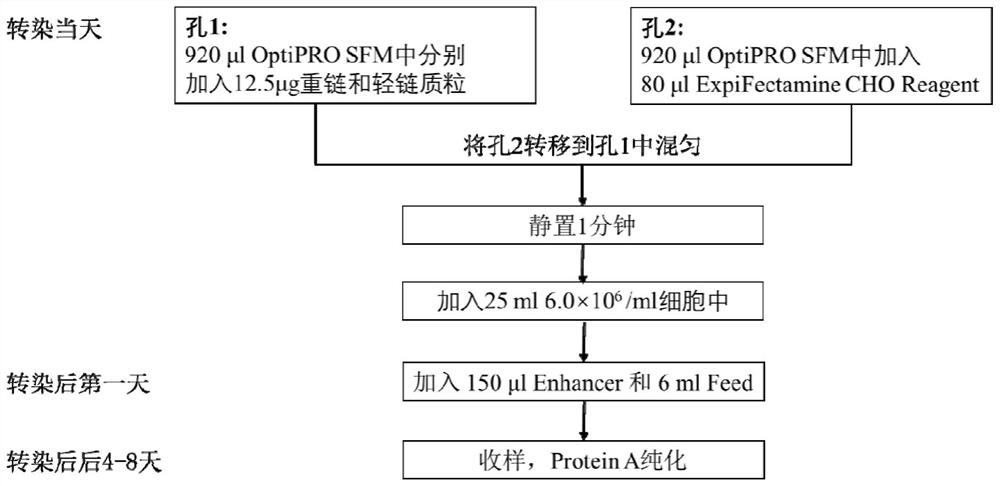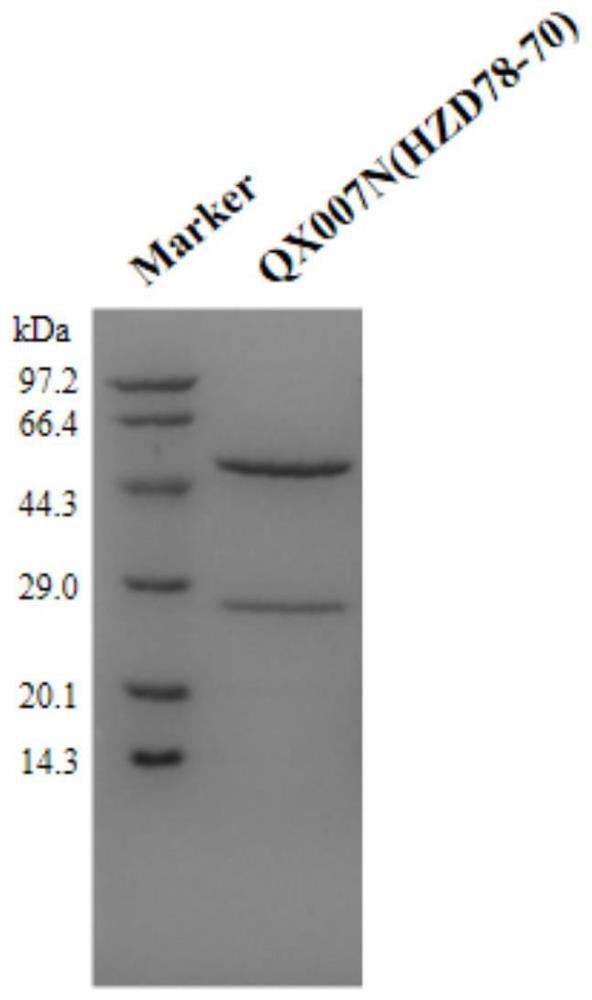Affinity purification method for reducing content of host cell protein in production of anti-human interleukin-33 monoclonal antibody
A host cell protein, monoclonal antibody technology, applied in the biological field, can solve the problems of low cost of materials, process amplification, host cell protein residue, etc., and achieve good clinical effect, good stability, and the affinity purification process is simple and easy to implement. Effect
- Summary
- Abstract
- Description
- Claims
- Application Information
AI Technical Summary
Problems solved by technology
Method used
Image
Examples
Embodiment 1
[0131] Example 1 Preparation of anti-human interleukin-33 monoclonal antibody QX007N
[0132] Purchasing human interleukin-33 (hIL-33) from Shanghai Nearshore Technology Co., Ltd. was used to immunize New Zealand rabbits. Using B cell cloning technology to obtain antigen-binding specific antibody clones, and then screened out human interleukin-33 binding and human interleukin-33 33 monoclonal antibodies that inhibit activity. First, use Binding ELISA to detect cell supernatants, and select clones that bind to human interleukin-33; then use HEK Blue TM The IL-33 reporter gene cell method was used for detection, and clones with human interleukin-33 inhibitory activity were selected. The above immunization and screening processes are entrusted to commercial companies.
[0133] Twelve clones were successively selected for recombinant expression and sequenced. It was determined that 78# had the best cell neutralizing activity, and 78# was humanized. Use NCBI IgBlast to carry o...
Embodiment 2
[0138] Embodiment 2 Equilibrium dissociation constant (K D ) determination
[0139] Biacore T200 was used to detect the affinity of QX007N(HZD78-70) to human interleukin-33, and all processes were carried out at 25°C. Using a commercial Protein A chip, an appropriate amount of antibody was immobilized by the capture method, so that the Rmax was around 50RU, and the capture flow rate was 10 μl / min. The antigen was serially diluted, the flow rate of the instrument was switched to 30 μl / min, and the concentration flowed through the reference channel and the channel of the immobilized antibody in order of concentration from low to high, and the buffer was used as a negative control. After each association and dissociation, the chip was regenerated with pH 1.5 glycine. Use the analysis software that comes with the instrument to select the 1:1 binding model in the Kinetics option for fitting, and calculate the binding rate constant k of the antibody a , the dissociation rate cons...
Embodiment 3
[0144] Example 3 neutralizes HEK Blue induced by human interleukin-33 TM Activity Detection of NF-κB / AP-1 Signal Transduction in IL-33 Cells
[0145] HEK Blue TM IL-33 cells were generated by stably transfecting human embryonic kidney cells HEK 293 with human IL1RL1 gene, and the responses of TNF-α and IL-1β were blocked, so HEK-Blue TM IL-33 cells specifically respond to IL-33. The binding of interleukin-33 to IL-1RL1 / IL-1RAcP on the cell surface triggers a signal cascade reaction, leading to NF-κB / AP-1 signal transduction and production of secreted alkaline phosphatase (secreted alkaline phosphatase, SEAP), which can be detected Interleukin-33 biological activity or antibody screening.
[0146] Utilize HEK Blue TM The neutralizing activity of QX007N(HZD78-70) to human interleukin-33 was determined in IL-33 cells. HEK Blue TM IL-33 cells at 4×10 per well 4 Cells were plated into 96 wells at 37°C and 5% CO 2 conditions overnight. Dilute the antibody to a concentr...
PUM
 Login to View More
Login to View More Abstract
Description
Claims
Application Information
 Login to View More
Login to View More - R&D
- Intellectual Property
- Life Sciences
- Materials
- Tech Scout
- Unparalleled Data Quality
- Higher Quality Content
- 60% Fewer Hallucinations
Browse by: Latest US Patents, China's latest patents, Technical Efficacy Thesaurus, Application Domain, Technology Topic, Popular Technical Reports.
© 2025 PatSnap. All rights reserved.Legal|Privacy policy|Modern Slavery Act Transparency Statement|Sitemap|About US| Contact US: help@patsnap.com



